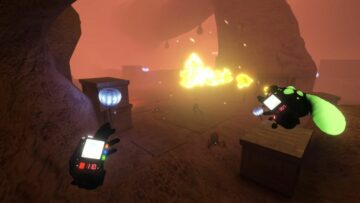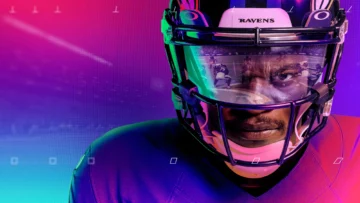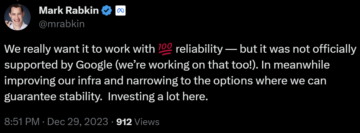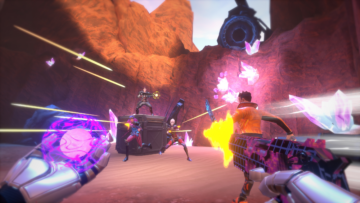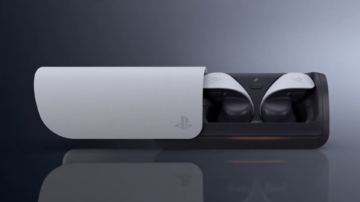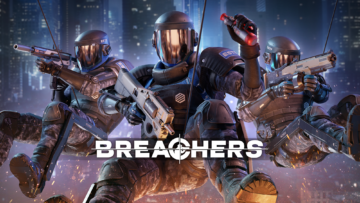Unplugged is the biggest and most ambitious game to go all-in on hand tracking on Quest, bringing your air guitar dreams to life. While it has its limitations, the game ultimately offers a hand tracking concept that surpasses everything else on the Quest platform. Here’s our full Unplugged review.
Before getting into detail, let’s get something straight about Unplugged: the feeling of using just your hands to act out air guitar moves (in what is essentially VR’s spiritual successor to Guitar Hero) is a completely unmatched experience and technical accomplishment on Oculus Quest. No other hand tracking experience comes even remotely close in terms of sheer thrill and innovation. Developer Anotherway has caught onto something magical here: it has brought to life an activity that, up until now, only existed in your imagination. This game doesn’t simulate real life guitar — it instead embarks on a fantasy-fulfilling journey of letting you feel like a true rockstar, shredding through air and playing to a pumping crowd.
Now, that’s not to say that the game doesn’t have it’s limitations or quirks — we’ll get to those later — but it’s important to impress just how amazing Unplugged can feel in its best moments. For all its faults or shortcomings, it genuinely feels like the start of a franchise that harnesses hand tracking in a way that no other app has been able to do, both on a conceptual and technical level.
Anotherway’s Debut, Mastered By Vertigo
Unplugged started as a side project by Ricardo Acosta in April 2020, but was picked up by publisher Vertigo Games in December. Gone are the days of bulky, plastic peripherals — using a VR headset lets the genre move towards something more immersive and thrilling, keeping the same spirit while also doing its own thing.
However, it’s not quite as technical or advanced as Guitar Hero or Rock Band, in terms of the complexity of the songs — as Jamie pointed out in his hands-on, you won’t be busting out Through the Fire and the Flames in Unplugged just yet.
That being said, the game still gets surprisingly complex — more than you would think it would be able to, given the limitations of Quest’s hand tracking technology. Just look at the video embedded above of Get The Funk Out by Extreme on Hard difficulty — it’s one of the game’s later tracks and really pushes chord changes and fast notes strumming to its limits. I found myself constantly surprised at just how far Anotherway have pushed the Quest’s capabilities — nothing else that uses hand tracking has been able to display such a degree or speed or accuracy.
A Rocking Tracklist
Vertigo Games’ publishing has also allowed Unplugged to launch with a solid tracklist of well-known rock songs, especially for a debut rhythm game. There’s Say It Ain’t So by Weezer, Bohemian Like You by The Dandy Warhols, Should I Stay Or Should I Go by The Clash and The Kids Aren’t Alright by The Offspring, to name a few. Even the lesser known tracks have clearly been picked with care — each track feels distinct and offers a slightly different style of mapping, depending on the feel of the song itself.
Songs are unlocked through records, collections of 4-5 tracks. Each record has three challenges that you have to complete in order to unlock the next record, such as achieving a minimum score on certain difficulties across tracks. Each song has three difficulties — Easy, Normal, Hard — all of which share similar styles of mapping, but up the complexity of the chord shapes, chord changes and the strumming patterns. Each new record also comes with its own venue, working up from a small bar to an arena.
Learning the Ropes
Unplugged is not an easy game — it takes a lot of getting used to on several levels. At first, I was tempted to say the game is too difficult, particularly because high scores require high combos, which involves nailing long stretches of perfect notes without stuffing anything up. After a few days with the game, I started to realize that the difficulty ramp is pretty much spot on. Not only do the songs get harder across each difficulty setting, but each new record marks an increase in complexity as well.
However, there is much to learn. It takes a lot of adjustment and trial and error before you start to understand the conditions under which the game works best, particularly for accurate tracking. In my first few hours with Unplugged, I had sessions that were amazing and others where it felt like nothing was working and the game wasn’t picking up everything accurately, leading to heaps of frustration.
Three days in, I cracked the code and was able to play for hours on end from with little to no tracking issues. Once you figure it what works, it’s magical. But to get that point, you might have to spend some time getting to grips with what works best for accurate tracking, especially as the songs and progression conditions become more complicated.
This isn’t really the fault of Anotherway per se — the limitations and frustrations come more from the technology itself, as opposed to design decision — but the game could definitely do a better job of explaining the technical requirements for ideal tracking beyond initial setup of your play area.

The tutorial, led by Steel Panther’s Satchel, gives you an overview of standard hand tracking advice — roll up your sleeves, turn lights on, make sure there is high contrast between your hands and the background, wipe the outside tracking camera lenses.
However, it’s everything that comes after that I felt needed more explanation. I wish the game told you more specifically what it was looking for — where is it best to position the guitar relative to your body? When you say hold the pick, do you mean with two fingers or my entire hand? When strumming, is it better to telegraph the strum with wrist movements or more of a whole arm movement?
There’s basically no explanation of this stuff, so you’re left to figure it out through trial and error. That might be to avoid breaking immersion, or because the ideal conditions will vary for each user. But it’s a highly technical game that needs high accuracy to be at its best, so it’s frustrating how little guidance there is beyond the initial play area setup.
In my case, I found the best results when I positioned the guitar perpendicular and slightly out from my body, not angled against my hip like a real guitar. I positioned it higher than comfortable (or more Beatles Liverpool Cavern Club and less Dave Grohl Arena Tour height, if you will), which both helped with tracking and somewhat forced me to strum more distinctly with my wrist, which I found was more accurate than whole arm strumming.
You also don’t have to pretend you’re holding a guitar neck — while there’s a guitar neck in-game, you’re best off pushing your fingers against your palm when making chord shapes. Don’t leave a gap between your fingers and your palm for the imaginary neck — it makes you slower and chord changes harder.
If the game had told me all that from the outset it could have saved confusion. But once you get past that period of initial experimentation and you find what works, the game feels absolutely amazing.
Rocking Gameplay
With that initial tracking acclimatization aside, the game really opens up and you’re able to pull off some very complex sequences. You start to feel like a rock god and the game comes into its own as you progress through the latter half of the records. There’s also a sense of manageable challenge — you learn and gradually master songs as you become more acquainted with them, and I found myself replaying tracks over and over to try improve my previous high score. It’s really addictive.
The first few tracks start you off with simple shapes — all four fingers, or just three — and then gradually introduces more shapes and different finger combinations as the difficulty ramps up. Anotherway is aware that some shapes are harder to change to than others, and often compensates by smartly saving more complex shapes for the second half of a song, once you’re used to the rhythm and patterns, ready for more of a challenge. It’s well thought out for the most part, but there are nonetheless some transitions that feel really difficult to nail accurately.
The focus of each track is not replicating guitar lines one-to-one, but instead mapping different patterns to the general rhythm of the guitar parts or, when missing, other instruments or vocals. There are also slide notes, which only require you to move your fret hand over them without strumming, and vibrato sustained notes that you can shake on the fret for extra points. Solos are the highlights of each map, which tend to focus on slide and vibrato notes as well as special shredding sequences that let you shred mindlessly to your heart’s delight for super fast sections of select songs. Most of the game’s solos feel wholly satisfying when you nail them.
While the songs are super satisfying and well crafted, there is a slight issue with latency, which is inherently present in any hand tracking experience. If you try to use the visual cue of the note hitting the fret to keep in time, often you’ll miss the note or it just feels slightly off-time. It’s hard to describe, because it’s such a miniscule delay that is almost imperceptible, but it’s definitely persistent across all songs. I found the best way to get around this was look slightly ahead of the fret and use the music itself to guide my timing, not the visual cues. This not only keeps you more in time, but it also keeps you focused on upcoming chord changes, which is essential for keeping your combo going.
Another issue is that the rhythm of the mapping does not always match the spacing of the notes coming towards the fret. Some songs are worse offenders than others (looking at you, Bohemian Like You), but I found instances where the game was expecting a certain timing/rhythm but visually, the notes looked to be evenly spaced between each other. It’s troublesome and means some songs you just have to either know the music or play through a few times to get the hang of the timing. Despite that, it’s far from a dealbreaker.
On higher difficulties, a few more challenges and mini games are introduced, such as ‘cursed’ flaming notes that you have to hit just right. If you miss them, the string will go out of tune and a guitar neck appears floating next to you, slowing down time and forcing you to re-tune the peg to resume playing. I never really enjoyed the tuning minigame and found it to be a tedious punishment that killed immersion. Likewise, some songs have sections where chords patterns are obscured right up until they’re about to be played, which I also found to be more tedious than challenging.
There are some nice bonus touches though, such as being able to amp up the crowd after a good run, which boosts you score and grants you points to spend on new cosmetic guitars.
Unplugged Review – Final Verdict
Despite its few flaws like tedious minigames and a lack of modifiers, Unplugged feels like the first proper app to take Quest’s hand tracking to a new conceptual and technical level. Even if you could hypothetically rework the game to support Touch controllers, doing so would defeat the point. At its core, Unplugged uses hand tracking as a way to fulfil a fantasy and bring to life something that previously only existed in your imagination. It sounds too good to be true, but it does mostly work as intended, even if it takes a bit of experimenting to find and understand the right tracking conditions.
For those reasons, Unplugged still a few years ahead of its time. It works well enough right now, don’t get me wrong, but I can’t wait for the technology to improve ever so slightly, just enough to catch up with the concept. This definitely isn’t a bad thing — it actually makes me excited to see how emerging VR/AR technology (such as Facebook’s BCI finger-tracking tech) evolves the game over the next few years. Anotherway and Vertigo have found a concept and gameplay loop that can only improve with time — it’s just a matter of providing an experience that matches the level of technology on offer at each step of the way. Don’t let that deter you from playing Unplugged now though — it’s more than worth trying. The results are truly magical and unlike anything else on Quest. Unplugged really does strike a chord.


For more on how we arrived at this rating, read our review guidelines. What did you make of our Unplugged review? Let us know in the comments below!
- 100
- advice
- All
- amp
- app
- April
- AREA
- ARM
- around
- BEST
- Biggest
- Bit
- body
- care
- Catch
- caught
- challenge
- change
- club
- code
- coming
- comments
- confusion
- content
- Dave
- delay
- Design
- detail
- Developer
- DID
- dreams
- experience
- FANTASY
- FAST
- Figure
- Fire
- First
- flaws
- Focus
- Franchise
- Frustrations
- full
- game
- gameplay
- Games
- gap
- General
- good
- grants
- guide
- hand tracking
- Headset
- here
- High
- hold
- How
- HTTPS
- immersive
- Increase
- Innovation
- issues
- IT
- Job
- keeping
- kids
- leading
- LEARN
- Led
- Level
- Long
- looked
- Making
- map
- Match
- move
- moves
- Music
- Oculus
- Oculus Quest
- offer
- Offers
- opens
- order
- Other
- Others
- PC
- plastic
- platform
- present
- project
- Publishing
- quest
- Ramp
- reasons
- records
- Requirements
- Results
- review
- Roll
- Run
- saving
- sense
- setting
- Share
- Simple
- Slowing
- small
- So
- speed
- spend
- Spot
- start
- started
- stay
- steel
- support
- Technical
- Technology
- time
- touch
- track
- Tracking
- trial
- tutorial
- us
- Video
- vr
- VR Headset
- wait
- What is
- Work
- works
- worth
- years
- youtube

